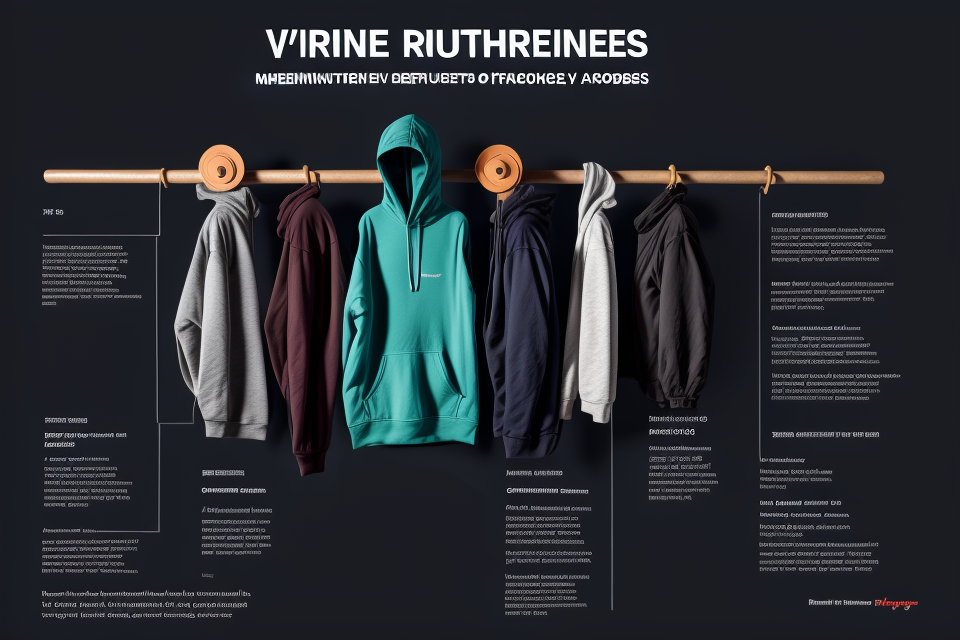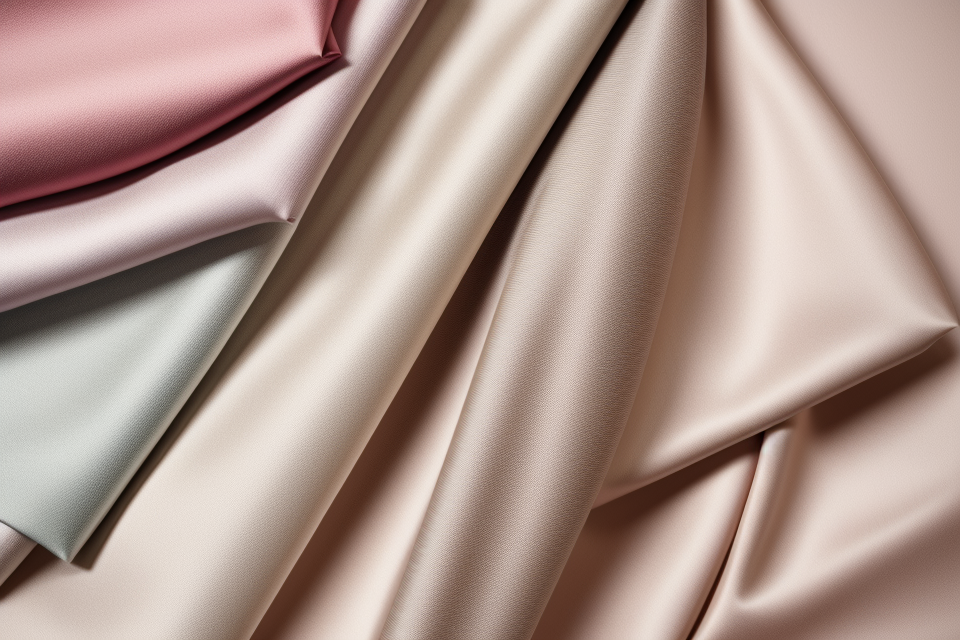
Hoodies have become a staple in everyone’s wardrobe, providing comfort and style for any occasion. But have you ever wondered about the materials used to make this versatile garment? In this article, we’ll delve into the world of hoodie fabric and explore the different types of materials used to create this classic piece of clothing. From cotton to fleece, we’ll examine the pros and cons of each material, and help you choose the perfect fabric for your next hoodie purchase. So, let’s get started and find out what makes a hoodie truly great!
A hoodie is a type of sweatshirt that has a hood in the back to cover the head and neck. The materials used to make a hoodie can vary, but most commonly it is made from a blend of cotton and polyester. This blend provides a comfortable, warm, and durable fabric that is perfect for casual wear. The cotton provides softness and breathability, while the polyester adds strength and resistance to shrinkage. Some hoodies may also include other materials such as spandex or elastane for a more fitted and flexible design. Additionally, the inside of the hoodie may be lined with a soft, warm fabric such as fleece for added comfort.
Types of Materials Used for Hoodies
Cotton
Cotton is one of the most commonly used materials for making hoodies. It is a natural fiber that is derived from the cotton plant, which is grown in warm and dry climates. The cotton fibers are soft, fluffy, and highly absorbent, making them ideal for use in clothing.
Advantages of using cotton for hoodies
- Comfortable: Cotton is a soft and comfortable material that is gentle on the skin. It is also breathable, which means that it can wick moisture away from the body, keeping the wearer cool and dry.
- Durable: Cotton is a strong and durable material that can withstand regular wear and tear. It is also resistant to wrinkles, which means that hoodies made from cotton can maintain their shape and size even after multiple washes.
- Affordable: Cotton is an affordable material that is widely available. It is also easy to care for, which means that hoodies made from cotton can be washed and dried without any special care.
Disadvantages of using cotton for hoodies
- Heavy: Cotton is a heavy material that can make hoodies feel bulky and warm. This can be a disadvantage for people who live in hot climates or for those who want to wear a lightweight and breathable hoodie.
- Shrinkage: Cotton is prone to shrinkage when it is washed. This can cause hoodies made from cotton to become smaller and less comfortable to wear over time. It is important to follow the care instructions carefully to prevent shrinkage.
Polyester
Polyester is a synthetic fabric that is commonly used in the production of hoodies. It is made from polymers that are created through a chemical reaction between diols and dicarboxylic acids. Polyester is known for its durability, resistance to wrinkles, and low cost.
One of the main advantages of using polyester for hoodies is its resistance to wear and tear. Polyester fibers are strong and can withstand a lot of stress and strain, making it an ideal material for activewear. Additionally, polyester is resistant to moisture, which means that it can be worn for extended periods without becoming uncomfortable or damp.
Another advantage of polyester is its versatility. It can be manufactured to have a variety of different finishes, including smooth, soft, and textured. This makes it suitable for a range of different hoodie designs and styles.
However, there are also some disadvantages to using polyester for hoodies. One of the main issues is that it can feel stiff and uncomfortable against the skin, especially in warmer weather. Additionally, polyester is not a breathable fabric, which means that it can make the wearer feel hot and sweaty.
Overall, while polyester has its advantages, it may not be the best choice for everyone. It is important to consider personal preferences and the intended use of the hoodie when deciding on the most suitable material.
Blends
Blended materials are a popular choice for making hoodies due to their unique properties. These materials are made by combining two or more different types of fibers to create a fabric that offers a combination of advantages. Some of the most common blends used for hoodies include cotton-polyester, cotton-viscose, and polyester-spandex.
Advantages of using blended materials for hoodies:
- Comfort: Blended materials are often softer and more comfortable than pure fabrics, making them ideal for hoodies.
- Durability: Blended materials are generally more durable than pure fabrics, making them resistant to wear and tear.
- Breathability: Some blended materials are more breathable than pure fabrics, allowing air to circulate and preventing the wearer from overheating.
- Versatility: Blended materials can be made to feel lightweight or heavy, depending on the desired texture and feel.
Disadvantages of using blended materials for hoodies:
- Cost: Blended materials can be more expensive to produce than pure fabrics, making them less accessible to some consumers.
- Sustainability: Some blended materials may not be as environmentally friendly as pure fabrics, depending on the types of fibers used and the manufacturing process.
- Maintenance: Some blended materials may require special care instructions, such as washing inside out or avoiding high temperatures during drying.
Factors to Consider When Choosing Hoodie Materials
Comfort
When choosing materials for a hoodie, comfort is a crucial factor to consider. The material used can greatly impact the wearer’s experience, affecting their level of warmth, breathability, and overall comfort. Here are some key points to consider when it comes to comfort:
- Importance of comfort in hoodie materials:
- Comfort is an essential aspect of any clothing item, including hoodies. A hoodie that is not comfortable can be unpleasant to wear, and may not be worn as often.
- When selecting materials for a hoodie, it is important to consider the fabric’s softness, warmth, and breathability. These factors can greatly impact the wearer’s experience and their likelihood of wearing the hoodie.
- How different materials affect comfort:
- Different materials can have varying levels of comfort. For example, a hoodie made from cotton is typically soft and comfortable, but may not provide as much warmth as a hoodie made from synthetic materials.
- Fleece material is often used in hoodies because of its softness and warmth. However, it can also be quite heavy and may not be as breathable as other materials.
- Polyester is another popular material for hoodies because of its warmth and durability. However, it can be less soft and breathable than other materials.
- When choosing a material for a hoodie, it is important to consider the intended use and the wearer’s preferences. For example, a hoodie intended for outdoor activities in cold weather may require a different material than a hoodie intended for casual wear.
Durability
Importance of Durability in Hoodie Materials
Durability is a crucial factor to consider when choosing materials for a hoodie. A hoodie is an essential piece of clothing that is meant to be worn frequently, and it is important that it can withstand the wear and tear of regular use. A hoodie that is not durable will not last long, and will need to be replaced frequently, which can be expensive and inconvenient.
How Different Materials Affect Durability
Different materials have different levels of durability. For example, cotton is a popular material for hoodies, but it is also one of the least durable. Cotton hoodies can become thin and worn quickly, especially if they are washed and dried frequently. On the other hand, materials like polyester and nylon are more durable and can withstand more wear and tear. These materials are also resistant to water and wrinkles, which makes them ideal for active wear. However, they can be less comfortable to wear than cotton, and may not be as breathable.
Another factor to consider is the construction of the hoodie. A hoodie that is made with a double stitched hood and reinforced seams will be more durable than one that is not. Additionally, hoodies that have a lining or are made with a fleece material will also be more durable than those that do not.
In conclusion, when choosing materials for a hoodie, it is important to consider the level of durability. While cotton may be soft and comfortable, it is not as durable as other materials like polyester and nylon. Additionally, the construction of the hoodie can also affect its durability. It is important to weigh the pros and cons of each material and construction when making a decision.
Cost
When choosing materials for a hoodie, cost is an important factor to consider. The cost of the materials can greatly impact the final price of the hoodie, and can even determine whether a hoodie is profitable for a business to produce.
The cost of hoodie materials can vary depending on the type of material used. For example, cotton is generally less expensive than fleece, but may not be as warm or durable. Polyester, on the other hand, is often more expensive than cotton, but can be more affordable than fleece in some cases.
In addition to the type of material, the quality of the material can also impact the cost. Higher quality materials, such as premium fleece or high-end cotton, will generally be more expensive than lower quality materials. However, higher quality materials may also be more durable and provide a better overall product.
When considering cost, it is important to balance the cost of the materials with the desired quality and functionality of the hoodie. It is also important to consider the target market and the price point at which the hoodie will be sold. For example, a hoodie intended for high-end fashion may have a higher material cost, while a hoodie intended for everyday wear may have a lower material cost.
Overall, cost is an important factor to consider when choosing materials for a hoodie, and businesses should carefully weigh the cost of materials against the desired quality and functionality of the hoodie.
Appearance
When choosing materials for a hoodie, the appearance of the final product is an important factor to consider. The material used can greatly affect the look and feel of the hoodie, and can even influence the way it is perceived by others.
Some materials, such as cotton, are known for their soft and comfortable feel, while others, like fleece, are prized for their warmth and insulation. In addition to these properties, different materials also have unique textures and colors that can greatly affect the overall appearance of the hoodie.
For example, a hoodie made from a lightweight, breathable material like mesh may be better suited for warm weather, while a heavier, more insulating material like denim may be more appropriate for colder temperatures. Ultimately, the choice of material will depend on the desired appearance and intended use of the hoodie.
Sustainability of Hoodie Materials
Environmental impact of different materials
When it comes to the environmental impact of hoodie materials, several factors need to be considered. These include the material’s source, the manufacturing process, and the end-of-life disposal. Here’s a closer look at some of the most common materials used to make hoodies and their environmental impact:
Cotton
Cotton is one of the most commonly used materials for hoodies, but it also has a significant environmental impact. Cotton is a water-intensive crop that requires large amounts of pesticides and fertilizers to grow. The production of cotton also generates a significant amount of waste and pollution. In addition, cotton is often grown in monoculture, which can lead to soil degradation and loss of biodiversity.
Polyester
Polyester is a synthetic material that is often used as a cheaper alternative to cotton. However, the production of polyester is highly energy-intensive and generates a significant amount of greenhouse gas emissions. In addition, polyester is not biodegradable and can take hundreds of years to decompose in landfills.
Organic Cotton
Organic cotton is grown without the use of synthetic pesticides and fertilizers, which reduces the environmental impact of cotton production. However, organic cotton is still water-intensive and requires large amounts of land to grow. In addition, the production of organic cotton can be more expensive than conventional cotton, which can make it less accessible to consumers.
Recycled Materials
Recycled materials, such as recycled polyester and recycled cotton, can help reduce the environmental impact of hoodie production. By using recycled materials, there is less demand for new raw materials, which reduces the amount of energy and resources needed for production. In addition, recycling reduces waste and helps to conserve natural resources.
Overall, the environmental impact of hoodie materials depends on several factors, including the material’s source, manufacturing process, and end-of-life disposal. Consumers can make a difference by choosing hoodies made from sustainable materials and supporting brands that prioritize sustainability in their production processes.
Recycling and upcycling
Recycling and upcycling are two strategies that can significantly contribute to the sustainability of hoodie materials. These methods not only reduce waste but also promote a more environmentally friendly approach to fashion.
Recycling is the process of converting used or waste materials into new, usable products. In the context of hoodies, recycling can involve using recycled cotton, polyester, or other synthetic fibers to create new fabric. This reduces the need for virgin materials and decreases the environmental impact of textile production.
Upcycling, on the other hand, is the process of transforming existing materials into something new and higher quality. In the case of hoodies, upcycling can involve using reclaimed cotton or polyester to create new fabric, or repurposing old hoodies into new designs. This not only reduces waste but also encourages creativity and innovation in fashion.
Both recycling and upcycling can help to create a more sustainable hoodie industry. By utilizing these methods, designers and manufacturers can reduce their environmental impact and create products that are both stylish and eco-friendly.
FAQs
1. What is a hoodie?
A hoodie is a type of sweatshirt that has a hood attached to the back of the neckline. The hood provides additional coverage for the head and neck, making it a popular choice for outdoor activities and casual wear.
2. What materials are commonly used to make a hoodie?
Hoodies can be made from a variety of materials, including cotton, polyester, fleece, and blends of these materials. Cotton hoodies are typically lightweight and breathable, while polyester hoodies are more durable and resistant to shrinking. Fleece hoodies are warm and cozy, making them ideal for colder weather.
3. What are the benefits of wearing a hoodie?
Hoodies are comfortable, versatile, and can be worn in a variety of settings. They are often made from soft, comfortable materials that provide warmth and insulation, making them a popular choice for outdoor activities and cold weather. Hoodies can also be worn as a casual, everyday garment.
4. How do I care for my hoodie?
The care instructions for a hoodie will depend on the specific material it is made from. In general, hoodies made from cotton or a cotton-polyester blend can be machine washed and dried on a low heat setting. Hoodies made from fleece should be washed by hand or in a lingerie bag and air dried to prevent shrinking. It is important to read the care label on your hoodie to ensure that it is cared for properly.


